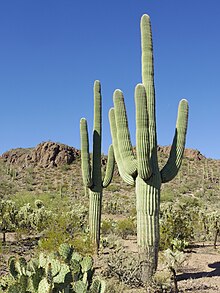Carnegiea gigantea
| Saguaro | |
|---|---|
 |
|
| Scientific classification | |
| Kingdom: | Plantae |
| (unranked): | Angiosperms |
| (unranked): | Eudicots |
| (unranked): | Core eudicots |
| Order: | Caryophyllales |
| Family: | Cactaceae |
| Subfamily: | Cactoideae |
| Tribe: | Pachycereeae |
| Genus: |
Carnegiea Britton & Rose |
| Species: | C. gigantea |
| Binomial name | |
|
Carnegiea gigantea (Engelm.) Britton & Rose |
|
 |
|
| Natural range of Carnegiea gigantea | |
| Synonyms | |
|
|
The saguaro (/səˈwɑːroʊ/, Spanish pronunciation: [saˈɣwaɾo]) (Carnegiea gigantea) is an arborescent (tree-like) cactus species in the monotypic genus Carnegiea, which can grow to be over 70 feet (21 m) tall. It is native to the Sonoran Desert in Arizona, the Mexican State of Sonora, and the Whipple Mountains and Imperial County areas of California. The saguaro blossom is the state wildflower of Arizona. Its scientific name is given in honor of Andrew Carnegie. In 1994, Saguaro National Park, near Tucson, Arizona, was designated to help protect this species and its habitat.
The image of the saguaro is indelibly linked with that of the American Southwest, especially in western films. The common name saguaro came into the English language through the Spanish language, originating in the Mayo language.
Saguaros have a relatively long lifespan, often exceeding 150 years. They may grow their first side arm any time from 75–100 years of age, but some never grow any arms. A saguaro without arms is called a spear. Arms are developed to increase the plant's reproductive capacity, as more apices lead to more flowers and fruit.
...
Wikipedia

